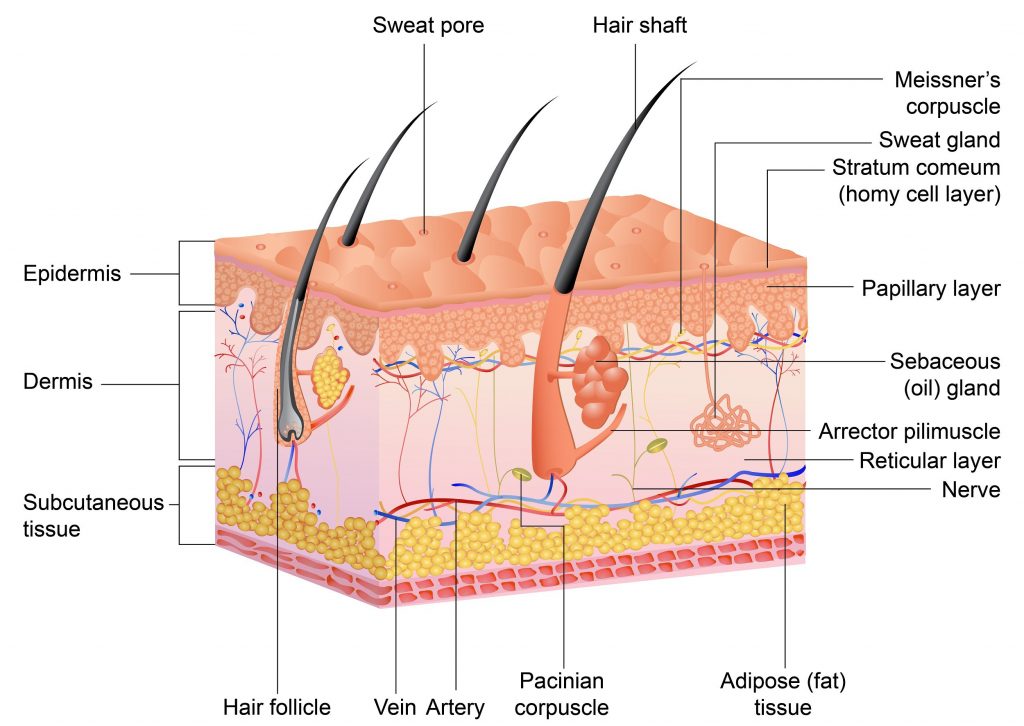What Does the Skin Do?
When you look at your skin, you may think that it’s not doing much. However, the skin is a very dynamic organ and is constantly changing. Here is a list of just some of the key functions of the skin:
- Protective barrier against injury
- Temperature regulation
- Prevents loss of moisture
- Detects infections
- Produces vitamin D
- Sensory organ for touch and temperature
- Protects body from ultraviolet radiation
Cool Skin Facts
Did you know how amazing your skin is? Here are some interesting facts about the skin:
- Your skin is approximately 15% of your bodyweight
- It is the largest organ of the body
- Surface area of the skin is about 1.8 square meters
- Skin renews itself every 28 days
- Skin sheds approximately 50,000 cells per minute
- Some of your touch receptors responde to pressure of 20 milligrams (or the weight of a fly)
- Average person has 300 million skin cells
- Thickest area of skin is on your feet
- Thinnest area of skin is on your eyelids

What are the Contents of the Skin?
The Skin has Three Main Layers
Epidermis
The epidermis is the very top layer of the skin and contains several different cell types. Keratinocytes are the main cell type of the epidermis. They produce keratin, which is a protein that provides strength and flexibility to the skin and waterproofs the skin surface. Keratinocytes are also referred to as squamous cells. When the keratinocytes are located at the bottom line of the epidermis they are called basal cells. Melanocytes contain a protein called melanin, which creates our skin color. Everyone has the same number of melanocytes and skin color is related to their activity. Langerhans cells are immune cells that reside in the skin. Merkel cells are cells that associate with sensory nerve endings.
Dermis
The dermis is the middle layer and encompasses many structures and cell types. Collagen and elastin are proteins found in the dermis that help our skin be firm yet stretchy and resilient. Fibroblasts are another cell type in the dermis that help synthesize collagen and elastin.
We also have small blood vessels in the dermis that provide nutrients to nourish the skin and provide circulation. Lymphatics are also located in the dermis and help protect our skin from harmful pathogens.
Hair follicles, sweat glands and sebaceous glands are also found in the dermis. Hair follicles are found in all areas of the body except the palms, soles, and mucosa (ie lips). Sweat glands are single tubular structures that open onto the skin and produce a watery substance that helps with temperature regulation. Sebaceous glands are coiled tubes associated with hair follicles that produce an oily substance called sebum that moisturizes the skin and hair. There is a muscle attached to the base of the hair follicle called the arrector pili muscle. When this muscle is stimulated it pulls the hair follicle upright leading to the appearance of many tiny raised bumps on our skin (“goosebumps”).
Nerve endings and receptors for touch, pressure, pain and temperature also reside in the dermis. Meissner’s corpuscules are the touch receptors that detect light touch. And Pacinian corpuscles detect deep pressure and vibration.
Subcutaneous
The subcutaneous layer is the bottom layer underneath the dermis. The subcutaneous tissue contains mostly connective tissue and fat. The connective tissue is firm fibrous strands that forms divisions between collections of fat and also anchors the dermis to your muscle and bones. The fat cells help to pad the muscles and bones and assists with body temperature regulation. There are also blood vessels and nerves in the subcutis that connect to the rest of your body. The base of sweat glands and sebaceous glands can also be found in the subcutaneous tissue.
